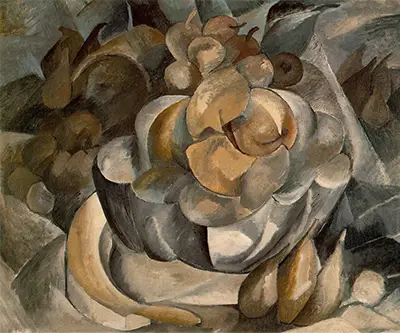The artist produced a number of paintings featuring fruit dishes and other tableware during this period, but most were done in a more modernist style, where form was entirely decipherable and understandable. By now, though, he was just starting to switch to the trademarks of the cubist style, with a darker, more subdued palette and also the greater abstraction of objects within the scene. Fruit Dish 1908-1909 offers that balance, where we can still just about make out every item in the painting, but it is clearly becoming harder to do so as compared to pieces from perhaps earlier in the year 1909, or across 1908. The composition itself features a plethora of fruit arranged around the fruit dish, as well as plenty of further fruit placed on the dish itself.
By this stage of abstraction, we are starting to find the background harder to understand, with many elements included. Are these just more items of fruit, or is something else going on? As perspective starts to distance itself from reality, our brains have fewer clues with which to work out answers for these questions. The fractured nature of cubism is still some way away, as angles are not disrupted here to anything like the same degree. Compare it to the likes of Violin and Candlestick and Violin and pitcher for examples of what we mean, where the development had continued on for a number of years, as well as adding in the collaborations with Picasso which aided the cubist movement's inception.
All in all, for the reasons mentioned previously, this is a lesser-known but still highly significant artwork from the career of Georges Braque which contains evidence of the transition that was occuring in his work at that time. Rather than just studying the different movements in which the artist was involved, it is fair more rewarding, and interesting, to see the slow change in his style as this development happened organically over time.


